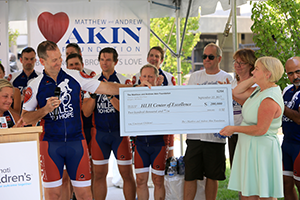Cyclists Complete Final HLH “700 Miles to Hope” Ride
Cyclists Complete Final HLH “700 Miles to Hope” Ride
Ride Funds Help Cincinnati Children’s, Families Battle Devastating Immune Disease
Friday, September 22, 2017
Bicyclists today complete their seventh and final annual trek on the grueling “700 Miles to Hope” from Natchez, Miss. to Cincinnati Children’s Hospital Medical Center. In the last seven years the riders raised more than $1 million for HLH research and treatment at the medical center, including $200,000 raised from this year’s cycling journey.
The bikers ended this year’s ride by presenting a check to Cincinnati Children’s and the HLH center during a welcome ceremony today.
Funds and awareness generated by the ride allow researchers at the Cincinnati Children’s HLH Center of Excellence to close the gap on an immune disorder that kills close to half of the children who get it. The ride was started by the Matthew and Andrew Akin Foundation, created by Kristin and Justin Akin of St. Louis. The Akins lost two sons, Matthew and Andrew, to HLH, an abbreviation for hemophagocytic lymphohistiocytosis.
HLH throws the immune system into irreversible overdrive. Children die from uncontrolled inflammation that destroys their blood cells and immune systems. Too often misdiagnosed and detected late, HLH has few treatments except bone marrow transplant, a procedure that comes with complications and risk.
New Drug Advances
The ride’s conclusion comes just after the U.S. Food and Drug Administration (FDA) in early September granted Rare Pediatric Disease Designation for a new drug to treat primary HLH. The drug – emapalumab (NI-0501) – was developed by the Swiss biopharmaceutical company Novimmune, a longtime sponsor of “700 Miles to Hope” and HLH research at Cincinnati Children’s.
The drug was granted Breakthrough Designation by the FDA in 2016. The intent of this designation is to expedite the development and review of new therapies for serious or life-threatening conditions that have shown encouraging early clinical results.
“This new drug helps bring HLH under control,” says Ashish Kumar, MD, PhD, a physician at the HLH Center of Excellence (Cincinnati Children’s Cancer and Blood Diseases Institute). “Basic research here by my colleague Michael Jordan, MD, helped spur the clinical trial that led to this. He led the trial and we enrolled a large number of patients to help show the drug has tremendous potential for treating HLH.”
Kumar, now making his fourth and final ride, will be joined this year by Jordan and other Cincinnati Children’s colleagues as part of the group making the 700-mile journey.
Justin Akin, who started the ride in memory of his sons, says the time has come to end the annual ride. The Akins have two adopted young sons who take much of their time, and the experience of losing two children to HLH has taught them that time is precious, he said.
“We feel like we’ve accomplished something,” Akin explains. “We’ve helped fund research and the increased awareness about HLH has helped us make sure the care of newly diagnosed children with HLH is transferred to Cincinnati Children’s, because there is a difference. And with the money we’ve raised we’ve been able to help these families transfer that care – whether it's to pay for a flight or an apartment while they are going through the bone marrow transplant process in Cincinnati."
Improving Diagnosis
Part of the ongoing effort to improve HLH treatment is making diagnosis of the disease more accurate. Misdiagnosis of the disease remains a challenge, according to Kumar.
Cincinnati Children’s is developing a diagnostic algorithm that researchers say shows potential for detecting HLH more accurately than current diagnostic methods.
“The HLH ride and Akin foundation have helped in more ways than can be measured, but we still have a lot of work do to further improve diagnosis and treatment,” Kumar says. “We are working on the enhanced diagnostic algorithm because we need a diagnostic tool that gives us answers much faster with much higher accuracy. But we are developing better tools and today we have a much better understanding of the pathology of HLH. It’s important that we help educate physicians around the world about this progress.”




